Indranil Chakraborty1*, Vikram S Karmarkar2
1General Surgery, Third Year SR in MCH Neurosurgery, Department of Neurosurgery, Bombay Hospital and Medical Research Centre, Mumbai, India
2Neurosurgery, Department of Neurosurgery, Bombay Hospital and Medical Research Centre, Mumbai, India
*Correspondence author: Indranil Chakraborty, MBBS, MS, General Surgery, Third Year SR in MCH Neurosurgery, Department of Neurosurgery, Bombay Hospital and Medical Research Centre, Mumbai, India;
Email: [email protected]
Published Date: 23-04-2023
Copyright© 2023 by Chakraborty I, et al. All rights reserved. This is an open access article distributed under the terms of the Creative Commons Attribution License, which permits unrestricted use, distribution, and reproduction in any medium, provided the original author and source are credited.
Abstract
Intramedullary astrocytomas of the spinal cord are rarer than intracranial astrocytomas. Glioblastoma Multiforme (GBM) generally does not involve the spinal cord (1-5% of all GBM cases) and presents as only 1.5% of all spinal cord tumors. The ratio of low-grade to high-grade astrocytomas in the spinal cord is about 3:1.
Case Report: We report a case of a 40-year-old male patient complaining of back pain. Insidious in onset, gradual in progression, deep-seated since 8 months. Walking has been difficult for 6 months due to associated foot drop in the left lower limb. There was no evidence of bowel or bladder involvement, and there were no complaints in the upper limbs or elsewhere. On examination, the motor system showed foot drop and EHL weakness in the left lower limb. Following that, he underwent D12-L1 laminectomy with subtotal excision of the lesion under neuromonitoring. Glioma was discovered on histopathology. Adjuvant radiation and chemotherapy were given.
Conclusion: The rarity of this entity may have hampered the development of standardized regimens for optimal treatment. We believe that accumulated experience in the treatment of this lethal condition might contribute well to improving its therapeutic outcome.
Keywords: Conus; Glioblastoma Multiforme; Intramedullary Tumor; Radiation Therapy; Spinal Cord
Introduction
Intramedullary astrocytomas of the spinal cord are less common than intracranial astrocytomas. Intramedullary astrocytomas are mainly of low grade, whereas high-grade astrocytomas, in comparison, rarely occur in the spinal cord. Glioblastoma Multiforme (GBM) generally does not involve the spinal cord (1-5% of all GBM cases) and is present in only 1.5% of all spinal cord tumors [1-6]. The ratio of low-grade to high-grade astrocytomas in the spinal cord is about 3:1 [2,3,6]. Glioblastoma multiforme accounts for about 1-3% of all primary intramedullary astrocytomas [2,3]. Even with aggressive management, these tumors are associated with severe disability and a dismal prognosis. They generally have a short clinical manifestation, usually less than a year [7]. Furthermore, it is more likely to develop in the cervical or cervicothoracic region in more than 60% of cases with a rare incidence in the conus medullaris [8-12].
Case Report
A 40-year-old male patient, right-handed, known diabetic, hypertensive, and on antiplatelets (stopped before surgery) had complaints of back pain: insidious in onset, gradual in progression, continuous deep sitting since 8 months, aggravated with movements, not relieved on taking rest or lying down, mildly relieved on taking painkillers. Pain radiating to bilateral lower limbs (Left > Right) for 8 months, with associated numbness and tingling sensation (ascending/more distally) and difficulty walking for 6 months due to associated foot drop in the left lower limb. No bowel or bladder involvement was seen. No complaints in the upper limbs or any other complaints.
Underwent D12-L1 laminectomy with subtotal excision of the lesion under neuromonitoring. Intraoperatively it showed an intramedullary lesion with an extramedullary extension. The initial histopathology diagnosis of glioma (Morphologically pilocytic astrocytoma) with GFAP was positive, ATRX was retained, IDH1 was negative, P53 was not overexpressed and Ki 67 was high (approximately 35%) (Table 1, Fig. 1-11).
Histopathological slide review at TATA Memorial Hospital is suggestive of cellular glial tumors of astrocytic morphology with florid foci of microvascular proliferation and occasional mitotic activity. Rosenthal fibers and densely hyalinized blood vessels. Retained ATRX, IDH1R132H MIB Index 12-15% positive, Olig 2 and p53 Positive. The final diagnosis was glioblastoma (Grade IV). A neurological examination revealed no new or worsening deficits. The patient developed hemodynamic instability on postoperative day 2 and was managed accordingly and received adjuvant therapy.

Figure 1: Sagittal showing iso-intense lesion, at conus.

Figure 2: Sagittal showing expanding lesion almost obliterating the cord in D12-L1 region.

Figure 3: T1 Axial showing lesion at the D12-L1.

Figure 4: T2 Axial showing lesion at the D12-L1.
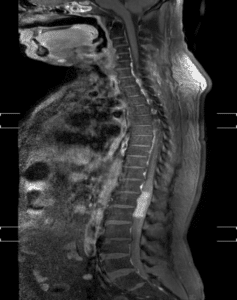
Figure 5: Post contrast sagittal image showing the enhancing lesion at the conus.
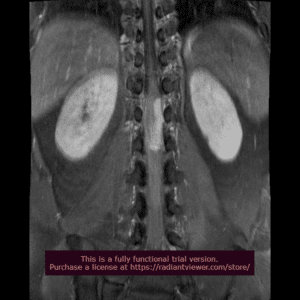
Figure 6: Post contrast coronal image showing the enhancing lesion at the conus.
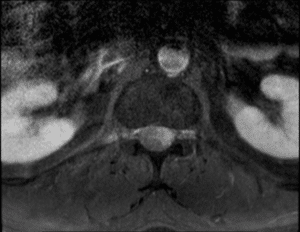
Figure 7: Post contrast axial [magnetic resonance imaging sequences of the lumbar spine demonstrating enhancing mass with surrounding edema within the conus medullaris.
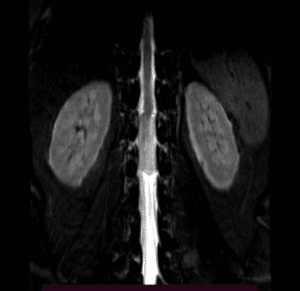
Figure 8: Myelogram Showing lesion at the conus.

Figure 9: Post contrast sagittal image showing the enhancing lesion at the conus.
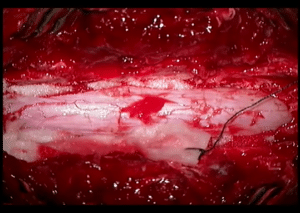
Figure 10: Showing the lesion adherent to surrounding nerve roots. Post laminectomy tumor was seen intramedullary with extradural component subtotal excision of lesion under neuromonitoring.
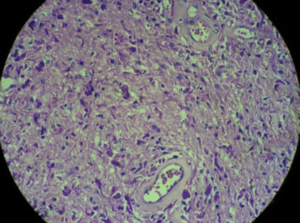
Figure 11: Histopathology shows high grade glioma.
No | Author | Age | Surgery | Radiation | Chemotherapy | Metastasis | Survival Time | Other |
/Sex | ||||||||
1 | Eden [43] | 19/M | Biopsy | No | No | SA and | 7 mo | CSF |
Interpduncular space | Protein raised | |||||||
Cerebellam | ||||||||
2 | O’Connel [44] | 16/M | Biopsy | 7500 r | No | SA space | 16 mo | Complete |
Ventricle | SA block | |||||||
3 | Tashiro [45] | 12/F | PR | No | No | SA,Cerebellum, | 11 mo | —– |
Hypothallamus, | ||||||||
Thalamus,Vemtricle | ||||||||
4 | Andrews [46] | 45/M | STR | 5000r | No | Septum | 13 mo | Hydrocephalous |
Ventricle | ||||||||
5 | Cohen [9] | 16/F | TR | Unknown | No | Septum | 6 mo | Hydrocephalous |
6 | Cohen [9] | 14/M | TR | Unknown | No | Intracranial | 4 mo | Hydrocephalous |
7 | Cohen [9] | 19/M | TR | Unknown | No | ——– | 17 mo | Hydrocephalous |
8 | Kawanishi [47] | 50/M | PR | 40 Gy | No | Cerebellum | 25 mo | Hydrocephalous |
Sylvian Fissure | ||||||||
Cingulate gyrus | ||||||||
9 | Shirato [11] | 35/F | PR | 65 Gy | ACNUVCR | ———– | 58 mo | —— |
10 | Strik [48] | 31/F | STR | 45 GY | No | Cerebellar | 15 mo | |
D8-L1 | Suprasellar | |||||||
+9 Gy | Region | |||||||
11 | Scarrow [4] | 62/M | Biopsy | 48 Gy | No | ——— | 4+ | —- |
T9-L3 | ||||||||
12 | Santi [49] | 23/M | STR/ | No | No | ——– | 8 mo | —— |
PR | ||||||||
13 | Banczerowski [50] | 56/M | Biopsy | 20-36Gy | No | ——— | 16 mo | —— |
14 | Banczerowski [50] | 41/M | STR | No | No | ——— | 3 mo | —— |
15 | Banczerowski [50] | 14/F | STR | No | BCNU | ——— | 11 mo | —- |
16 | Banczerowski [50] | 42/M | STR | 36 Gy | MTX | ——— | 10 mo | —– |
17 | Medhkour [17] | 20/M | STR x 2 | Unknown | Pontomedullary junction | 11 mo | —- | |
Cerebellum | ||||||||
Suprasellar | ||||||||
Cistern | ||||||||
18 | Stecco [19] | 14/M | STR | No | No | Posterior fossa | 10 mo | —— |
19 | Elsamatoly [17] | 20/M | STR x2 | Unknown | No | Suprasellar Cistern | 10 mo | —- |
Ventricle, | ||||||||
Cerebellar, | ||||||||
Brainstem | ||||||||
20 | Bonde [3] | 16/M | STR | Unknown | No | Simultaneous | 6 mo | —– |
Cervical-Medullary lesion | ||||||||
21 | Choi [16] | 46/M | STR | Unknown | TMZ | ———– | 8 + mo | Masque as high lumberdisc herniation |
22 | Sun [51] | 14/M | STR | Unknown | No | Illiac and Femoral Bone | 16 mo | Die of Cerebral herniation |
Lat.Cerebral Ventricle | ||||||||
23 | Sanborn [52] | 36/F | STR | Unknown | TMZ | ——— | ——— | —— |
24 | Mayer [53] | 28/F | STR | 30 Gy/ | PCB | ——— | 67/d | No lumber puncture |
T9-L3 | CCNU | |||||||
VCR | ||||||||
BNCU | ||||||||
25 | Mori [43] | 10/F | STR x2 | 18Gy/CM | VCR | Holocordal | 14 mo | Secondary |
+18Gy/ | CTX | Cervicomedullary junction | Hydrocephalous | |||||
whole | VP-16 | Pituitary stalk | ||||||
DDP | ||||||||
MTX | ||||||||
26 | Gee [54] | 9/F | Biopsy | Unknown | TMZ | 16 – 18 | 10 mo | —— |
Vertebral bodies | ||||||||
27 | Cacchione [55] | 4/M | STR | 4500cGY | TMZ | ——— | 52+ mo | ——- |
/CM | ||||||||
28 | Yan [25] | 10/M | TR | 15.3 Gy= | TMZ | Left apical lobe,Right cerebellar vermis,Corpus callosum | 14 mo | CSF Protein increased |
30.6 Gy/CM | Basal Ganglia | |||||||
Lateral ventricles | ||||||||
29 | Faycal [56] | 16/M | TR | 50-60 Gy | TMZ | T9 – conus | 10 mo | —— |
Corticosteroid | ||||||||
30 | Nunn [57] | 31/M | STR | 54 Gy | TMZ | T9-conus | 14 mo | Leptomeningeal involvement |
31 | Mausha [58] | 15/M | TR | 4500 cGy | TMZ | ———– | 1 mo | Cystic degenaration |
32 | Sanjeev [59] | 38/F | TR | 50 Gy | ——— | D11 to L1 | ——– | —— |
33 | Goodazzi [60] | 78/M | Biopsy | 54 Gy | TMZ | D9- conus | 2 weeks | —— |
34 | Gooda [61] | 25/M | STR | 54 Gy | ———– | T12-L1 | 24 mo | —— |
35 | Overzet [62] | 75/M | Biopsy | ——- | ———– | ———— | ——— | —— |
Table 1: Showing presentation of all reported conus medularis GBM.
Discussion
Intramedullary glioblastoma is a rare disease entity. It can develop primarily from the cord or as a secondary metastasis from the brain, which accounts for up to 25% of the total occurrences. Regardless of its origin, it has a predilection to develop from the cervicothoracic region in the primary cases, and it tends to develop at a young age which is in contrast to the present case. The conus is only rarely involved [13]. Despite adequate multimodality treatment, the prognosis remains guarded. The average period is only around 15 months [14]. Most spinal tumors are of benign etiology and only 10-15% show high-grade features that require histopathological confirmation [15]. In comparison with other low-grade gliomas, the progression of the disease is rapid and dramatic, with a time range of several weeks to months. Our patient had symptoms for a year. Because of its rapid nature, surgery is usually restricted to a role for rapid histologic diagnosis and the application of proper adjuvant therapy. With all these measures, the estimated survival of patients with intramedullary glioblastoma barely exceeds 12 to 24 months. Our patient was in follow-up for 12 months before his death.
Like other brain tumors, their spread follows CSF circulation in the same way as astrocytes disseminate in the craniocaudal direction [13,16,17]. Basal leptomeninges, basal cisterns, the fourth ventricle, or cranial nerves may get involved with anaplastic growth [17]. The anaplastic zone usually affects the cerebral ventricles and substitutes the ependyma cells [17]. The walls of the ventricles seem to become a relatively welcome “shelter” for newly appearing lesions. However, both direct dissemination and contiguous regions spread by cerebrospinal fluid seeding have been reported as likely explanations. The dissemination via CSF can reach up to 58% in spinal GBM, compared to 23% to 27% in cerebral GBM. [3,18].
Bladder dysfunction in CONUS involvement occurs due to disruption of autonomic fibers results in either retention or incontinence in up to 92% of patients. Bowel dysfunction results in retention or incontinence in up to 72% of patients). Saddle anesthesia or decreased sensation in the perineum occurs in up to 93% of patients). The onset of perineal anesthesia associated with bladder dysfunction is typical of the start of CONUS lesion and the time at which the clock starts on diagnosis and management. It is important also to note that painless urinary retention often has the greatest predictive value as a stand-alone symptom, but it is unfortunately indicative of late, often irreversible CONUS lesion.
Patients with malignant spinal cord astrocytomas can develop the disseminated disease, mostly via leptomeningeal spread through the subarachnoid space [19]. Another important factor in the overall survival period is secondary hydrocephalus [20]. Most commonly due to disturbance in circulation caused by increased CSF circulation (increased protein, arachnoiditis, spontaneous tumor bleed, occlusion of subarachnoid CSF channels).
Treatment of GBM of the CONUS consists of debulking of the tumor and high-dose postoperative radiation The absence of a cleavage plane between the tumor and adjacent healthy tissue obstructs clear-cut surgery. Surgical intervention could be a biopsy or gross total resection, but the goal is directed according to the preservation of neurological function. [21,22]. Studies reported that cordectomy elongates survival time by at least 6 years in a patient with thoracic GBM [23]. A case with GBM involving the CM survived more than 4 years after radiocordectomy [24]. Chemotherapy in an adjuvant setting with or without radiotherapy was tried in several cases [21,22,25,26]. Recent literature found an increase in 5-year progression-free survival rate and overall survival in 13 patients with malignant spinal astrocytomas, including four cases of GBM in children by ‘‘8-drugs-in-1-day’’ chemotherapy [21]. Intrathecal administration of interferon beta via the Ommaya reservoir was also carried out in conjunction with whole-brain and focal spinal cord irradiation [27]. Postoperative adjuvant therapy prolongs the life span of some patients [28]. The radiation dose at times may exceed the radiation tolerance level of the spinal cord. Many reported survival times between 6 and 16 months, with a mean survival timeframe of 12 months after diagnosis [27]. Some reported cases of survival timeframes of 6 and 16 months, with an average survival period of 12 months after diagnosis [27]. One recommendation showed that radiation is given in 2.5-Gy fractions 4 times weekly for a total dose of 40 to 50 Gy over 4-5 weeks. Our patient received a total dose of 45.9 Gy for the conus medullaris and an additional dose of radiation to the whole brain. However, the tumor still metastasized to the intracranial spaces.
Whether chemotherapy is required or not remains controversial, but a retrospective series of 8 cases proved that both TMZ and Bevacizumab were useful in improving survival. TMZ was recognized to be effective in intracranial GBM, and it is also generally used as adjuvant therapy to surgery and radiation in spinal GBM. For patients with spinal GBM, it is recommended that TMZ be used concomitantly during and after radiotherapy. In a study consisting of six patients, TMZ seemed to prolong the survival time of primary spinal GBM. Chamberlain and Johnston found bevacizumab may have some effects on those who failed to respond to radiation and TMZ therapy. In our analysis, patients who received either adjuvant radiotherapy or chemotherapy had a better survival trend than those with surgery alone.
With the development of molecular therapy, tumors can be investigated more thoroughly. Proliferative marker Ki-67 index/MIB-1 labeling should be studied/ examined as a part of the pathologic features of GBM. The ideal time for starting chemoradiation is questionable, but usually, a timeline of four to six weeks after surgery is optimal [29]. In general, the average survival timeframe for spinal GBMs tends to be 12-24 months. To the best of our knowledge, the longest reported survival time for people with spinal GBM is 64 months [30].
Conclusion
The entity’s rarity may make it difficult to establish standardized regimens for optimal treatment. We believe that accumulated experience in the treatment of this lethal condition might contribute well to improving its therapeutic outcome. The establishment of a standardized protocol will help in earlier diagnosis and increase the survival chance of the patient.
Conflict of Interest
The authors have no conflict of interest to declare.
References
- Cheshire WP, Ehle AL. Hemiparkinsonism as a complication of an Ommaya reservoir.Case report. J Neurosurg. 1990;73:7746.
- Walker FO, Hunt VP. Ballism: an association with ventriculoperitoneal shunting. Neurology. 1990;40:1004.
- Bonde V, Balasubramaniam S, Goel A. Glioblastoma multiforme of the conus medullaris with holocordal spread. J Clin Neuroscience. 2008;15(5):601-3.
- Scarrow AM, Rajendran P, Welch WC. Glioblastoma multiforme of the conus medullaris. Clin Neurol Neurosurg. 2000;102:166-7.
- Singh PK, Singh VK, Tomar J, Azam A, Gupta S, Kumar S. Spinal glioblastoma multiforme: Unusual cause of post-traumatic tetraparesis.J Spinal Cord Med. 2009;32:583-6.
- Gooskens RH, Kaiser MC, Veiga-Pires JA. Computerised tomography in the management of complications due to ventricular shunting. Neuroradiol. 1981;21:47-9.
- O’Brien CF, Chorea. In: Jankovic J, Tolosa E. Parkinson’s disease and movement disorders. 3rd Philadelphia: Lippincott Willimas and Wilkins; 1998;357-64.
- Asano N, Kitamura K, Seo Y. Spinal cord glioblastoma multiforme with intracranial dissemination. Neurol Med Chir Tokyo. 1990;30:489-94.
- Cohen AR, Wisoff JH, Allen JC. Malignant astrocytomas of the spinal cord. J Neurosurg. 1989;70:50-4.
- Grisold W, Pernetzky G, Jellinger K. Giant-cell glioblastoma of the thoracic cord. Acta Neurichir. 1981;58:121-6.
- Shirato H, Kamada T, Hida K. The role of radiotherapy in the management of spinal cord glioma. J Radiat Oncol Biol Phys. 1995;33:323-8.
- Cooper PR. Outcome after operative treatment of intramedullary spinal cord tumors in adults: intermediate and long-term results in 51 patients. Neurosurg. 1989;25:855-9.
- Zfilch KJ: Die Hirngeschwalste in biologischer und mor Phologischer Darstellung. 1995. JA Barth Publ.
- Marchan EM, Sekula RF, Jannetta PJ, Quigley MR. Long-term survival enhanced by cordectomy in a patient with a spinal glioblastoma multiforme and paraplegia: Case report. J Neurosurgery: Spine. 2007;7(6):656-9.
- Helseth A, Mørk SJ. Primary intraspinal neoplasms in Norway, 1955 to 1986. A population-based survey of 467 patients. J Neurosurg. 1989;71(6):842-5.
- Choi WC, Lee JH, Lee SH. Spinal cord Glioblastoma multiforme of conus medullaris masquerading as high lumbar disc herniation. Surg Neurol. 2009;71:234-7.
- Elsamaloty H, Zenooz NA, Mossa-Basha M. Glioblastoma Multiforme (GBM) of the conus medullaris with brain and brain stem metastases. Euro J Radiol Extra. 2006;58:59-62.
- Medhkour A, Chan M. Extremely rare gliobalstoma multiforme of the conus medullaris with holocord and brain stem metastases, leading to a cranial nerve deficit and respiratory failure: a case report and review of the literature. Surg Neurol. 2005;63:576-83.
- Stecco A, Quirico C, Giampietro A. Glioblastoma multiforme of the conus medullaris in a child: Description of a case and literature review. Am J Neuroradiol. 2005;26:2157-60.
- Jfinisch W, Schreiber D, GiJthert H: Neuropathologie – Tu morendes Nervensystems. Fischer Publ, Stuttgart, New York, 1988.
- Russell D, Rubinstein L: Pathology of tumors of the nervoussystem. (5 Ed.). E. Arnold Publ, London. 1989.
- Tendulkar RD, Pai PA, Wu S. Irradiation of pediatric high-grade spinal cord tumors. Int JRadiat Oncol Biol Phys. 2010;78:1451-6.
- Ciappetta P, Salvati M, Capoccia G, Artico M, Raco A, Fortuna A. Spinal glioblastoma: report of seven cases and review of the literature. Neurosurg. 1991;28(2):302- 6.
- Schijman E, Zúccaro G, Monges JA. Spinal tumors and hydrocephalus. Pediatric Neurosurgery. 1981;8(6):401-5.
- Yan C, Kong X, Yin H, Wang Y, He H, Zhang H, et al. Glioblastoma multiforme in conus medullaris with intracranial metastasis after postoperative adjuvant therapy. Medicine. 2017;96(13):e6500.
- Adams H, Avendaño J, Raza SM, Gokaslan ZL, Jallo GI, Quiñones-Hinojosa A. Prognostic factors and survival in primary malignant astrocytomas of the spinal cord: a population-based analysis from 1973 to 2007. Spine. 2012;37(12).
- Asano N, Kitamura K, Seo Y, Mukai K, Soga T, Kondo H, et al. Spinal cord glioblastoma multiforme with intracranial dissemination: Case report. Neurologia Medico-Chirurgica. 1990;30(7):489-94.
- Allen JC, Aviner S, Yates AJ. Treatment of high-grade spinalcord astrocytoma of childhood with ‘‘8-in-1’’ chemotherapy and radiotherapy: a pilot study of CCG-945. Children’s Cancer Group. J Neurosurg. 1998;88:215-20.
- Govindan A, Chakraborti S, Mahadevan A. Histopathologic and immunohistochemical profile of spinal glioblastoma: a study of six cases. Brain Tumor Pathol. 2011;28:297-303.
- Marchan EM, Sekula RF Jr, Jannetta PJ, Quigley MR. Long-term survival enhanced by cordectomy in a patient with a spinal glioblastoma multiforme and paraplegia. Case report. J Neurosurg Spine. 2007;7:656-9.
- Shirato H, Kamada T, Hida K. The role of radiotherapy in the management of spinal cord glioma. Int J Radiat Oncol Biol Phys. 1995;33:323-8.
- McGirt MJ, Goldstein IM, Chaichana KL. Extent of surgical resection of malignant astrocytomas of the spinal cord: outcome analysis of 35 patients. Neurosurg. 2008;63:55-60.
- Santi M, Mena H, Wong K,. Spinal cord malignant astrocytomas. Clinicopathologic features in 36 cases. Cancer. 2003;98:554-61.
- Minehan KJ, Brown PD, Scheithauer BW. Prognosis and treatment of spinal cordastrocytoma. Int J Radiat Oncol Biol Phys. 2009;73:727-33.
- Yi S, Choi S, Shin DA, Choi J, Ha Y, Kim KN, et al. Impact of H3.3 K27M mutation on prognosis and survival of grade IV spinal cord glioma on the basis of new 2016 World Health Organization classification of the central nervous system. Neurosurg. 2019;84(5):1072-81.
- Ozgiray E, Akay A, Ertan Y. Primary glioblastoma of the medulla spinalis: a report of three cases and review of the literature. Turk Neurosurg. 2013;23:828-34.
- Chen JR, Yao Y, Xu HZ, Qin ZY. Isocitrate Dehydrogenase (IDH)1/2 mutations as prognostic markers in patients with glioblastomas. Medicine (Baltimore). 2016;95:e2583.
- Parsons DW, Jones S, Zhang X. An integrated genomic analysis of human glioblastoma multiforme. Science. 2008;321:1807-12.
- Hegi ME, Diserens AC, Gorlia T. MGMT gene silencing and benefit from temozolomide in glioblastoma. N Engl J Med. 2005;352:997-1003.
- Shen CX, Wu JF, Zhao W, Cai ZW, Cai RZ, Chen CM. Primary spinal glioblastoma multiforme: a case report and review of the literature. Medicine (Baltimore). 2017;96:e6634.
- Timmons JJ, Zhang K, Fong J, Lok E, Swanson KD, Gautam S, et al. Literature review of spinal cord glioblastoma. Am J Clin Oncol. 2018;41(12):1281-7.
- Ciappetta P, Salvati M, Capoccia G, Artico M, Raco A, Fortuna A. Spinal glioblastomas: report of seven cases and review of the literature. Neurosurg. 1991;28(2)):302-6.
- Mori K, Imai S, Shimizu J. Spinal glioblastoma multiforme of the conus medullaris withholocordal and intracranial spread in a child: a case report and review of the literature. Spine J. 2012;12:e1-6.
- Eden KC. Dissemination of a glioma of the spinal cord in the leptomeninges. Brain. 1938;61:298-310.
- O’Connell JEA. The subarachnoid dissemination of spinal tumour. J Neuro Neurosurg and Psychiatry. 1946;9:55-62.
- Tashiro K, Tachibana S, Tsura M. Clinicopathological studies of spinal cord neoplasm with disseminating intracranial metastasis possibly producing akinetics mutism. No to shinkei Brain and Nerve. 1976;28(12):1311-8.
- Andrews AA, Enriques L, Renaudin J. Spinal intramedullary glioblastoma with intracranialseeding: Report of a case. Arch Neurol. 1978;35:244-5.
- Kawanishi M, Kuroiwa T, Nagasawa S. A case of spinal glioblastoma with intracranial dissemination. No shinkei geka. Neurolog Surg. 1993;21:1109-12.
- Stupp R, Mason WP, van den Bent MJ. Radiotherapy plus concomitant and adjuvanttemozolomide for glioblastoma. N Engl J Med. 2005;352:987-96.
- Santi M, Mena H, Wong K. Spinal cord malignant astrocytomas. Clinicopathologic features in 36 cases. Cancer. 2003;98:554-61.
- Banczerowski P, Simó M, Sipos L. Primary intramedullary glioblastoma multiforme of the spinal cord: report of eight cases. Ideggyogy Sz. 2003;56:28-32.
- Sun J, Wang Z, Li Z. Microsurgical treatment and functional outcomes of multi-segment intramedullary spinal cord tumors. J Clin Neurosci. 2009;16:666-71.
- Sanborn MR, Pramick M, Brooks J. Glioblastoma multiforme in the adult conus medullaris. J Clin Neurosci. 2011;18:842-3.
- Mayer RR, Warmouth GM, Troxell M. Glioblastoma multiforme of the conus medullaris in a 28-year-old female: a case report and review of the literature. Clin Neurol Neurosurg. 2012;114:275-7.
- Gee TS, Ghani AR, Idris B. Case report: a rare case of pediatric conus medularisglioblastoma multiforme. Med J Malaysia. 2012;67:439.
- Cacchione A, Mastronuzzi A, Cefalo MG. Pediatric spinal glioblastoma of the conusmedullaris: a case report of long survival. Chin J Cancer. 2016;35:44.
- Fayçal L, Mouna B. Rare case of conus medullaris glioblastoma multiforme in a teenager. Surgical Neurology International. 2017;8:234.
- Scarrow AM, Rajendran P, Welch WC. Glioblastoma multiforme of the conus medullaris. Clin Neurol neurosurg. 2000;102(3):166-7.
Article Type
Case Report
Publication History
Received Date: 24-03-2023
Accepted Date: 17-04-2023
Published Date: 23-04-2023
Copyright© 2023 by Chakraborty I, et al. All rights reserved. This is an open access article distributed under the terms of the Creative Commons Attribution License, which permits unrestricted use, distribution, and reproduction in any medium, provided the original author and source are credited.
Citation: Chakraborty I, et al. A Case Report of Conus Medullaris Tumor Causing a Diagnostic Dilemma and Review of Literature. J Neuro Onco Res. 2023;3(1):1-13.

Figure 1: Sagittal showing iso-intense lesion, at conus.

Figure 2: Sagittal showing expanding lesion almost obliterating the cord in D12-L1 region.

Figure 3: T1 Axial showing lesion at the D12-L1.

Figure 4: T2 Axial showing lesion at the D12-L1.

Figure 5: Post contrast sagittal image showing the enhancing lesion at the conus.

Figure 6: Post contrast coronal image showing the enhancing lesion at the conus.

Figure 7: Post contrast axial [magnetic resonance imaging sequences of the lumbar spine demonstrating enhancing mass with surrounding edema within the conus medullaris.

Figure 8: Myelogram Showing lesion at the conus.

Figure 9: Post contrast sagittal image showing the enhancing lesion at the conus.

Figure 10: Showing the lesion adherent to surrounding nerve roots. Post laminectomy tumor was seen intramedullary with extradural component subtotal excision of lesion under neuromonitoring.

Figure 11: Histopathology shows high grade glioma.
No | Author | Age | Surgery | Radiation | Chemotherapy | Metastasis | Survival Time | Other |
/Sex | ||||||||
1 | Eden [43] | 19/M | Biopsy | No | No | SA and | 7 mo | CSF |
Interpduncular space | Protein raised
| |||||||
Cerebellam | ||||||||
2 | O’Connel [44] | 16/M | Biopsy | 7500 r | No | SA space | 16 mo | Complete |
Ventricle | SA block | |||||||
3 | Tashiro [45] | 12/F | PR | No | No | SA,Cerebellum, | 11 mo | —– |
Hypothallamus, | ||||||||
Thalamus,Vemtricle | ||||||||
4 | Andrews [46] | 45/M | STR | 5000r | No | Septum | 13 mo | Hydrocephalous |
Ventricle | ||||||||
5 | Cohen [9] | 16/F | TR | Unknown | No | Septum | 6 mo | Hydrocephalous |
6 | Cohen [9] | 14/M | TR | Unknown | No | Intracranial | 4 mo | Hydrocephalous |
7 | Cohen [9] | 19/M | TR | Unknown | No | ——– | 17 mo | Hydrocephalous |
8 | Kawanishi [47] | 50/M | PR | 40 Gy | No | Cerebellum | 25 mo | Hydrocephalous |
Sylvian Fissure | ||||||||
Cingulate gyrus | ||||||||
9 | Shirato [11] | 35/F | PR | 65 Gy | ACNUVCR | ———– | 58 mo | —— |
10 | Strik [48] | 31/F | STR | 45 GY | No | Cerebellar | 15 mo | |
D8-L1 | Suprasellar | |||||||
+9 Gy | Region | |||||||
11 | Scarrow [4] | 62/M | Biopsy | 48 Gy | No | ——— | 4+ | —- |
T9-L3 | ||||||||
12 | Santi [49] | 23/M | STR/ | No | No | ——– | 8 mo | —— |
PR | ||||||||
13 | Banczerowski [50] | 56/M | Biopsy | 20-36Gy | No | ——— | 16 mo | —— |
14 | Banczerowski [50] | 41/M | STR | No | No | ——— | 3 mo | —— |
15 | Banczerowski [50] | 14/F | STR | No | BCNU | ——— | 11 mo | —- |
16 | Banczerowski [50] | 42/M | STR | 36 Gy | MTX | ——— | 10 mo | —– |
17 | Medhkour [17] | 20/M | STR x 2 | Unknown | Pontomedullary junction | 11 mo | —- | |
Cerebellum | ||||||||
Suprasellar | ||||||||
Cistern | ||||||||
18 | Stecco [19] | 14/M | STR | No | No | Posterior fossa | 10 mo | —— |
19 | Elsamatoly [17] | 20/M | STR x2 | Unknown | No | Suprasellar Cistern | 10 mo | —- |
Ventricle, | ||||||||
Cerebellar, | ||||||||
Brainstem | ||||||||
20 | Bonde [3] | 16/M | STR | Unknown | No | Simultaneous | 6 mo | —– |
Cervical-Medullary lesion | ||||||||
21 | Choi [16] | 46/M | STR | Unknown | TMZ | ———– | 8 + mo | Masque as high lumberdisc herniation |
22 | Sun [51] | 14/M | STR | Unknown | No | Illiac and Femoral Bone | 16 mo | Die of Cerebral herniation |
Lat.Cerebral Ventricle | ||||||||
23 | Sanborn [52] | 36/F | STR | Unknown | TMZ | ——— | ——— | —— |
24 | Mayer [53] | 28/F | STR | 30 Gy/ | PCB | ——— | 67/d | No lumber puncture |
T9-L3 | CCNU | |||||||
VCR | ||||||||
BNCU | ||||||||
25 | Mori [43] | 10/F | STR x2 | 18Gy/CM | VCR | Holocordal | 14 mo | Secondary |
+18Gy/ | CTX | Cervicomedullary junction | Hydrocephalous | |||||
whole | VP-16 | Pituitary stalk | ||||||
DDP | ||||||||
MTX | ||||||||
26 | Gee [54] | 9/F | Biopsy | Unknown | TMZ | 16 – 18 | 10 mo | —— |
Vertebral bodies | ||||||||
27 | Cacchione [55] | 4/M | STR | 4500cGY | TMZ | ——— | 52+ mo | ——- |
/CM | ||||||||
28 | Yan [25] | 10/M | TR | 15.3 Gy= | TMZ | Left apical lobe,Right cerebellar vermis,Corpus callosum | 14 mo | CSF Protein increased |
30.6 Gy/CM | Basal Ganglia | |||||||
Lateral ventricles | ||||||||
29 | Faycal [56] | 16/M | TR | 50-60 Gy | TMZ | T9 – conus | 10 mo | —— |
Corticosteroid | ||||||||
30 | Nunn [57] | 31/M | STR | 54 Gy | TMZ | T9-conus | 14 mo | Leptomeningeal involvement |
31 | Mausha [58] | 15/M | TR | 4500 cGy | TMZ | ———– | 1 mo | Cystic degenaration |
32 | Sanjeev [59] | 38/F | TR | 50 Gy | ——— | D11 to L1 | ——– | —— |
33 | Goodazzi [60] | 78/M | Biopsy | 54 Gy | TMZ | D9- conus | 2 weeks | —— |
34 | Gooda [61] | 25/M | STR | 54 Gy | ———– | T12-L1 | 24 mo | —— |
35 | Overzet [62] | 75/M | Biopsy | ——- | ———– | ———— | ——— | —— |
Table 1: Showing presentation of all reported conus medularis GBM.


